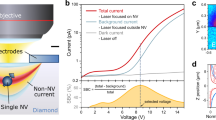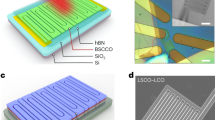Abstract
The development of a robust light source that emits one photon at a time will allow new technologies such as secure communication through quantum cryptography1. Devices based on fluorescent dye molecules2, quantum dots3 and carbon nanotubes4 have been demonstrated, but none has combined a high single-photon flux with stable, room-temperature operation. Luminescent centres in diamond5,6,7,8,9 have recently emerged as a stable alternative, and, in the case of nitrogen-vacancy centres, offer spin quantum bits with optical readout10,11,12,13,14,15. However, these luminescent centres in bulk diamond crystals have the disadvantage of low photon out-coupling. Here, we demonstrate a single-photon source composed of a nitrogen-vacancy centre in a diamond nanowire, which produces ten times greater flux than bulk diamond devices, while using ten times less power. This result enables a new class of devices for photonic and quantum information processing based on nanostructured diamond, and could have a broader impact in nanoelectromechanical systems, sensing and scanning probe microscopy.
This is a preview of subscription content, access via your institution
Access options
Subscribe to this journal
Receive 12 print issues and online access
$259.00 per year
only $21.58 per issue
Buy this article
- Purchase on Springer Link
- Instant access to full article PDF
Prices may be subject to local taxes which are calculated during checkout




Similar content being viewed by others
Change history
23 February 2010
In the version of this Letter initially published online, the fourth sentence of the abstract was incorrect. This error has been corrected in all versions of the text.
References
Beveratos, A. et al. Single photon quantum cryptography. Phys. Rev. Lett. 89, 187901 (2002).
Lounis, B. & Moerner, W. E. Single photons on demand from a single molecule at room temperature. Nature 407, 491–493 (2000).
Englund, D. et al. Controlling the spontaneous emission rate of single quantum dots in a two-dimensional photonic crystal. Phys. Rev. Lett. 95, 013904 (2005).
Högele, A., Galland, C., Winger, M. & Imamoğlu, A. Photon antibunching in the photoluminescence spectra of a single carbon nanotube. Phys. Rev. Lett. 100, 217401 (2008).
Wang, C., Kurtsiefer, C., Weinfurter, H. & Burchard, B. Single photon emission from SiV centres in diamond produced by ion implantation. J. Phys. B 39, 37–41 (2006).
Gaebel, T. et al. Stable single-photon source in the near infrared. New J. Phys. 6, 98 (2004).
Aharonovich, I. et al. Two-level ultrabright single photon emission from diamond nanocrystals. Nano Lett. 9, 3191–3195 (2009).
Kurtsiefer, C., Mayer, S., Zarda, P. & Weinfurter, H. Stable solid-state source of single photons. Phys. Rev. Lett. 85, 290–293 (2000).
Beveratos, A. et al. Nonclassical radiation from diamond nanocrystals. Phys. Rev. A 64, 061802(R) (2001).
Jelezko, F. et al. Observation of coherent oscillations in a single electron spin. Phys. Rev. Lett. 92, 076401 (2004).
Prawer, S. & Greentree, A. D. Diamond for quantum computing. Science 320, 1601–1602 (2008).
Gurudev Dutt, M. V. et al. Quantum register based on individual electronic and nuclear spin qubits in diamond. Science 316, 1312–1316 (2007).
Neumann, P. et al. Multipartite entanglement among single spins in diamond. Science 320, 1326–1329 (2008).
Maze, J. R. et al. Nanoscale magnetic sensing with an individual electronic spin in diamond. Nature 455, 644–648 (2008).
Balasubramanian, G. et al. Nanoscale imaging magnetometry with diamond spins under ambient conditions. Nature 455, 648–652 (2008).
Park, Y.-S., Cook, A. K. & Wang, H. Cavity QED with diamond nanocrystals and silica microspheres. Nano Lett. 6, 2075–2079 (2006).
Larsson, M., Dinyari, K. N. & Wang, H. Composite optical microcavity of diamond nanopillar and silica microsphere. Nano Lett. 9, 1447–1450 (2009).
Fu, K.-M. C. et al. Coupling of nitrogen-vacancy centers in diamond to a GaP waveguide. Appl. Phys. Lett. 93, 234107 (2008).
Barclay, P. E., Fu, K.-M. C., Santori, C. & Beausoleil, R. G. Chip-based microcavities coupled to nitrogen-vacancy centers in single crystal diamond. Appl. Phys. Lett. 95, 191115 (2009).
Kolosev, R. et al. Wave–particle duality of single surface plasmon polaritons. Nature Phys. 5, 470–474 (2009).
Wang, C. F. et al. Fabrication and characterization of two-dimensional photonic crystal microcavities in nanocrystalline diamond. Appl. Phys. Lett. 91, 201112 (2007).
Lee, C. L. et al. Fabrication and characterization of diamond micro-optics. Diamond Rel. Mater. 15, 725–728 (2006).
Wang, C. F., Hu, E. L., Yang, J. & Butler, J. E. Fabrication of suspended single crystal diamond devices by electrochemical etch. J. Vac. Sci. Technol. B 25, 730–733 (2007).
Fairchild, B. A. et al. Fabrication of ultrathin single-crystal diamond membranes. Adv. Mater. 20, 4793–4798 (2008).
Hiscocks, M. P. et al. Diamond waveguides fabricated by reactive ion etching. Opt. Express 16, 19512–19519 (2008).
Hausmann, B. et al. Fabrication of diamond nanowires for quantum information processing applications. Preprint at <http://arXiv.org/abs/0908.0352> (2009).
Friedler, I. et al. Solid-state single photon sources: the nanowire antenna. Opt. Express 17, 2095–2110 (2009).
Epstein, R. J., Mendoza, F. M., Kato, Y. K. & Awschalom, D. D. Anisotropic interactions of a single spin and dark-spin spectroscopy in diamond. Nature Phys. 1, 94–98 (2005).
Gali, A., Fyta, M. & Kaxiras, E. Ab initio supercell calculations on nitrogen-vacancy center in diamond: electronic structure and hyperfine tensors. Phys. Rev. B 77, 155206 (2008).
Manson, N. B., Harrison, J. P. & Sellars, M. J. Nitrogen-vacancy center in diamond: model of the electronic structure and associated dynamics. Phys. Rev. B 74, 104303 (2006).
Acknowledgements
The authors would like to thank F. Huber for providing Fig. 1b. Helpful discussions with Q. Quan, E. Togan, I. Bulu, M. Lukin and F. Jelezko are acknowledged. We would also like to thank S. Hong, M. Grinolds, P. Maletinsky and A. Yacoby for confirmation of the ESR signal. Devices were fabricated in the Center for Nanoscale Systems (CNS) at Harvard. This work was supported in part by grants from National Science Foundation (awards ECCS-0708905 and PHY-0646094: Nanoscale Science and Engineering Center and ECCS-0708905) and the Defense Advanced Research Projects Agency (Quantum Entanglement Science and Technology program). T.B. is funded by the NDSEG and NSF fellowships.
Disclaimer
The views, opinions and/or findings contained in this publication are those of the author and should not be interpreted as representing the official views or policies, either expressed or implied, of the Defense Advanced Research Projects Agency or the Department of Defense.
Author information
Authors and Affiliations
Contributions
T.B. performed the experiments and analysed the data, B.H. and M.K. fabricated the diamond nanowire devices, and Y.Z. performed numerical modelling of the structure. J.M. contributed experimental tools and helped with the experiments. P.R.H. and M.L. conceived and designed the experiments. T.B. and M.L. wrote the paper. All authors discussed the results and commented on the manuscript.
Corresponding author
Ethics declarations
Competing interests
The authors declare no competing financial interests.
Rights and permissions
About this article
Cite this article
Babinec, T., Hausmann, B., Khan, M. et al. A diamond nanowire single-photon source. Nature Nanotech 5, 195–199 (2010). https://doi.org/10.1038/nnano.2010.6
Received:
Accepted:
Published:
Issue Date:
DOI: https://doi.org/10.1038/nnano.2010.6
This article is cited by
-
Quantum sensors for biomedical applications
Nature Reviews Physics (2023)
-
Neuronal growth on high-aspect-ratio diamond nanopillar arrays for biosensing applications
Scientific Reports (2023)
-
Quantum NETwork: from theory to practice
Science China Information Sciences (2023)
-
Recent advances in room temperature single-photon emitters
Quantum Information Processing (2023)
-
Single-photon Transport in a Waveguide-cavity-emitter System
International Journal of Theoretical Physics (2022)



